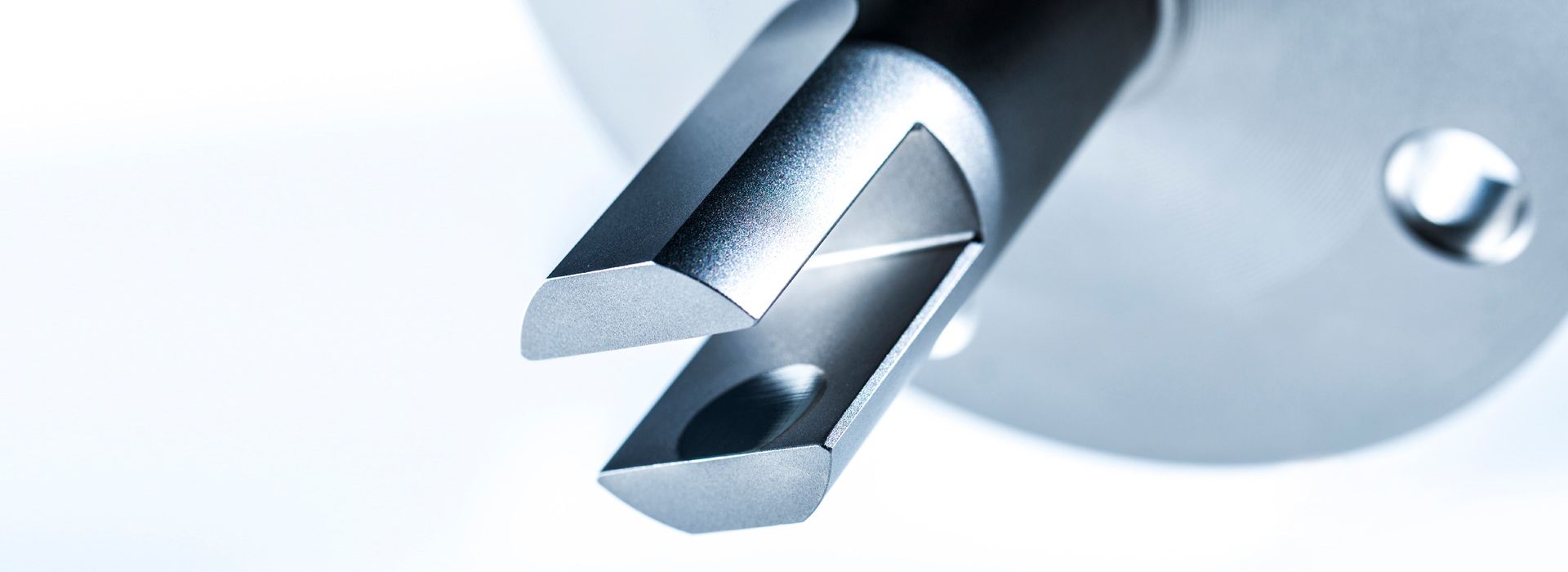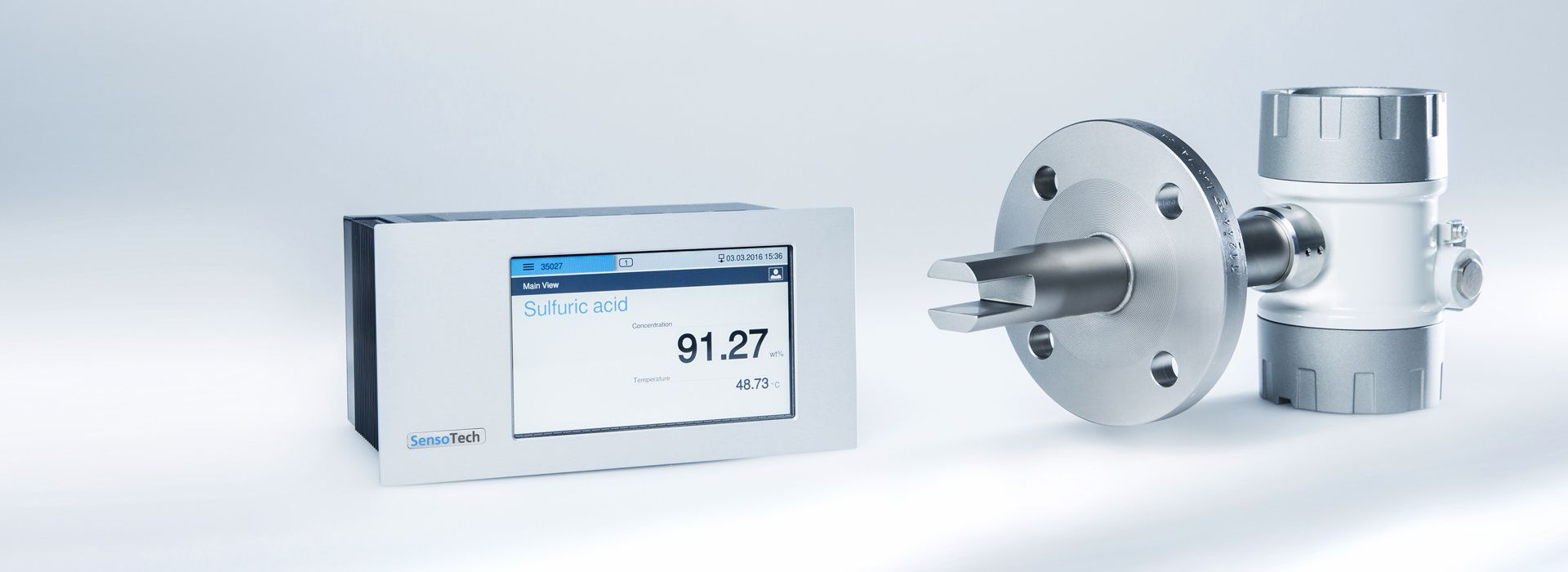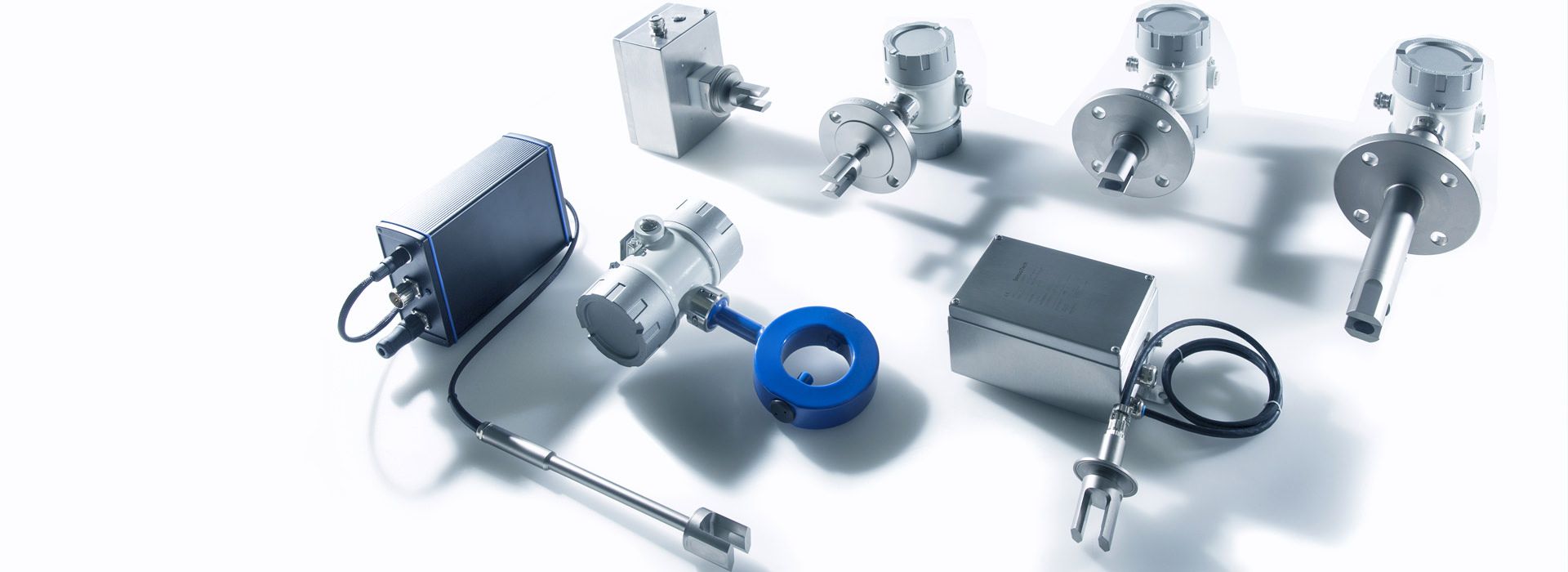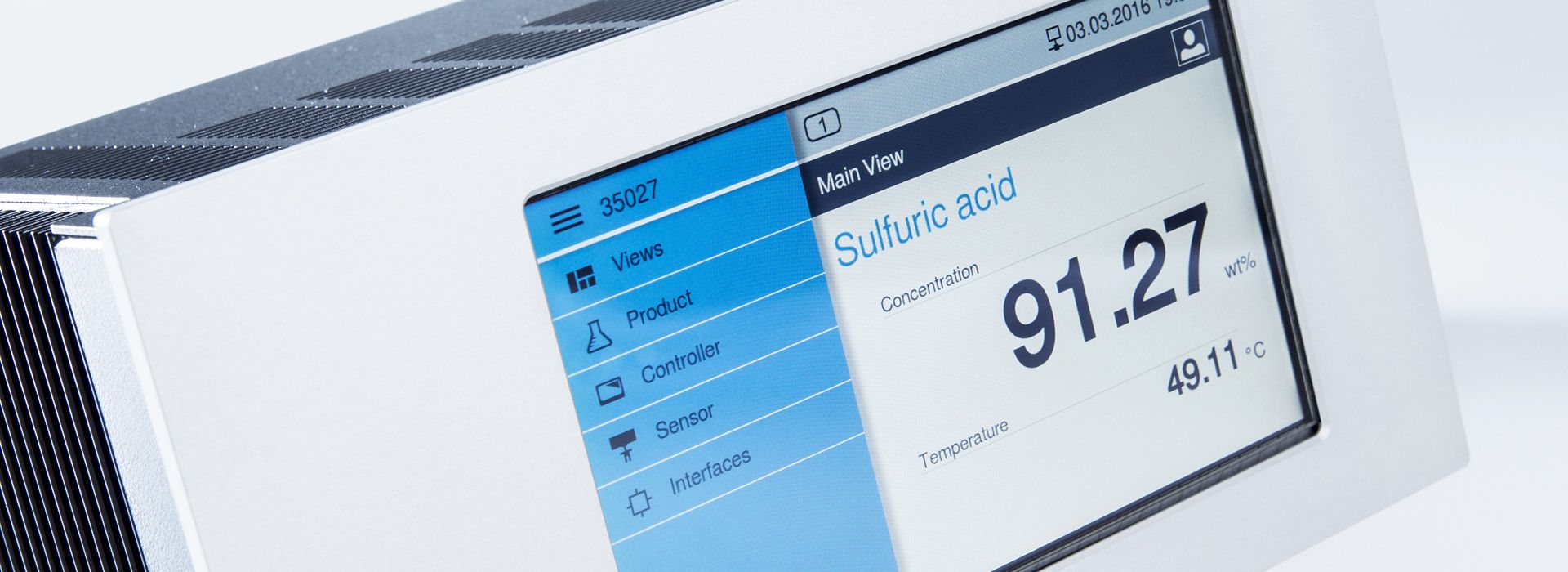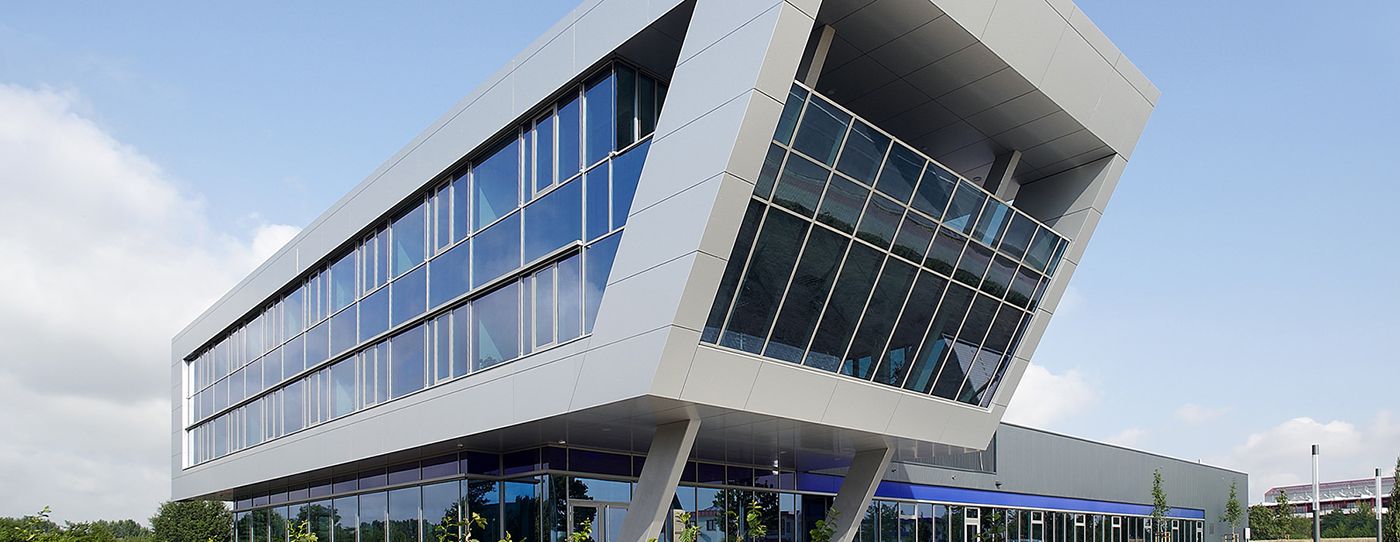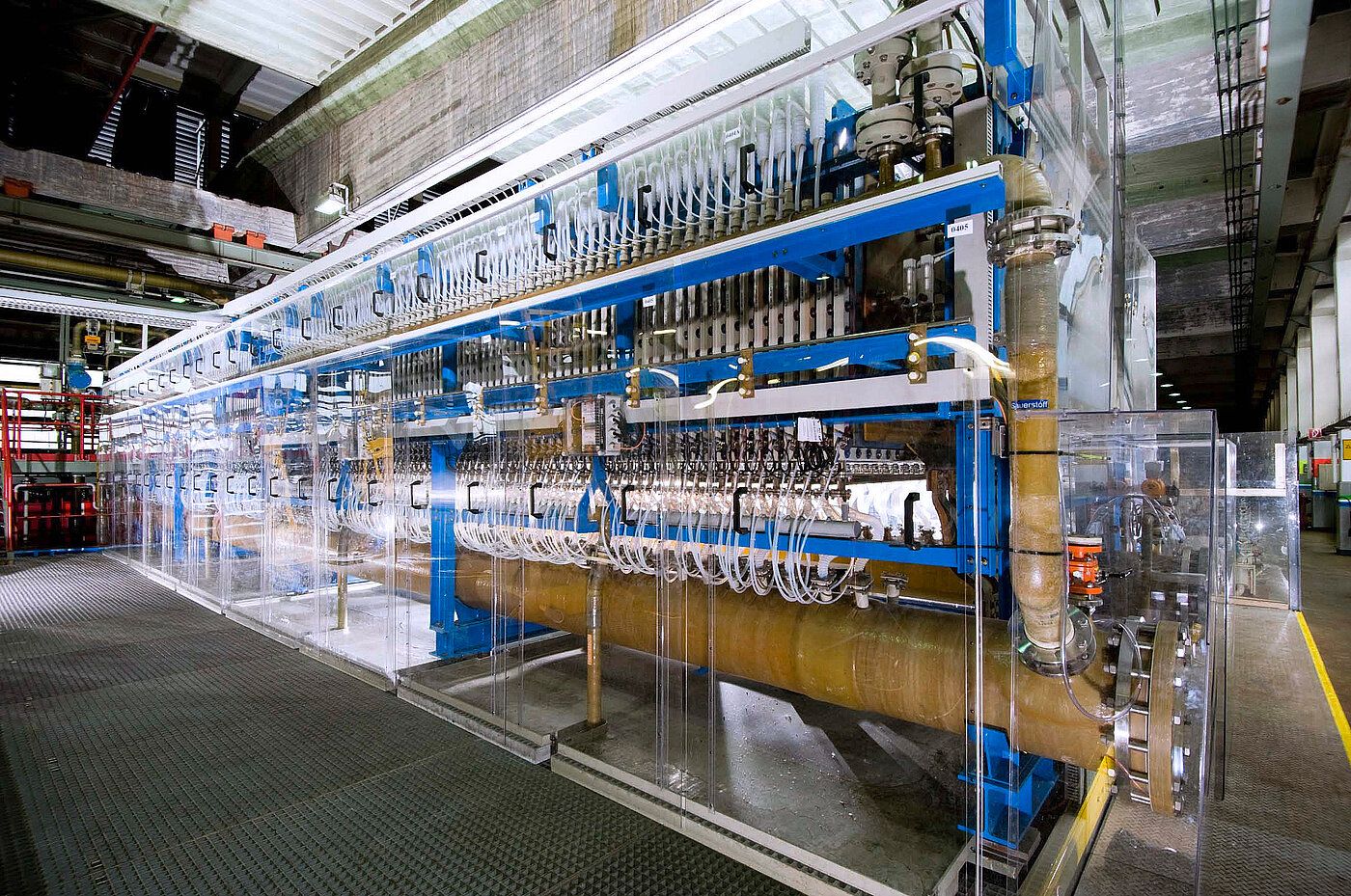Chlor-alkali electrolysis
At the heart of the modern chemical industry is chlor-alkali electrolysis, an indispensable process through which essential raw materials are obtained for various applications. This process technology is particularly important due to the efficient production of sodium ions (Na+), chloride ions (Cl−), and hydroxide ions (OH−), which are critical starting materials for the production of plastics, pharmaceuticals, and are indispensable in the textile industry.
By applying a direct electric voltage, the chlor-alkali electrolysis separates sodium chloride solution into elemental chlorine and sodium hydroxide; at the same time, hydrogen is produced. The functionality of these technically sophisticated electrolysis cells — specially designed to enable the transport of ions and at the same time prevent unwanted reactions between the products — is particularly valued among experts; because the efficiency and safety of the entire processdepend significantly on precise control mechanisms and the stability of the membrane technologies used.
LiquiSonic® Measuring systems in chlor-alkali electrolysis
The LiquiSonic® measurement technology can be advantageously used in the various process stages of chlor-alkali electrolysis. The customer benefit primarily lies in Reducing raw material and energy consumption as well as in Increasing the yield.
LiquiSonic® System
LiquiSonic® is available in three system variants:
LiquiSonic® 20, LiquiSonic® 30 and LiquiSonic® 40.
LiquiSonic® 30 is a high-performance system consisting of a controller with connections for up to four sensors. The sensors can be used at different measuring points.
LiquiSonic® 20 is a variant with reduced functionality and connection for one sensor.
LiquiSonic® 40 enables the simultaneous determination of two concentrations in a mixture. This involves combining a second physical measurement with the speed of sound. In chlor-alkali electrolysis processes, the LiquiSonic® 40 system usually includes a conductivity sensor as the second physical measurement.
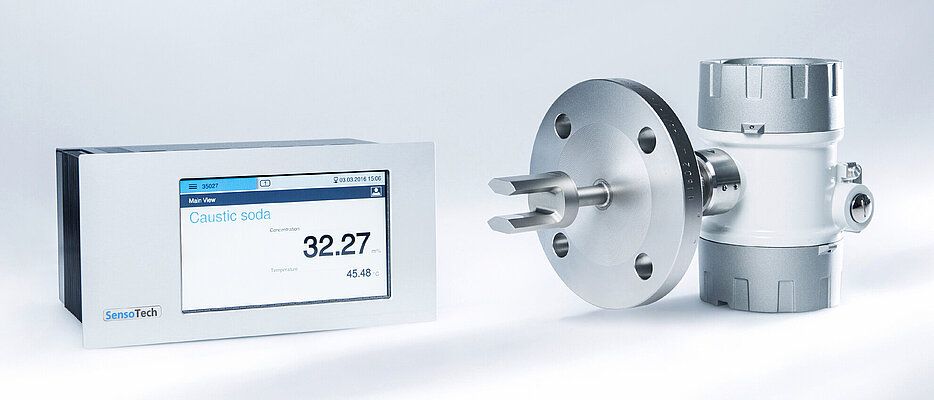
Measurement principle
The LiquiSonic® measurement technology analyzes liquid parameters such as concentration or density, detects phase transitions, and is used for reaction monitoring.
The measurement principle is based on determining the speed of sound in liquids. The distance (d) between the ultrasonic transmitter and receiver is constant by design, so the speed of sound (v) can be calculated by measuring the transit time (t) (v = d / t). Since the speed of sound depends on the concentration of the substance, there is a functional relationship that allows the concentration to be calculated.
The speed of sound measurement is independent of the transparency of the liquid and impresses with high measurement accuracy, reproducibility, and stability. In addition to speed of sound measurement, the LiquiSonic® Sensor a highly precise and fast temperature measurement for temperature compensation is integrated. For many applications, this offers significant advantages over conventional measurement methods.
Sensor
The LiquiSonic® Sensor continuously measures both the concentration and the temperature within the predefined range. The process data is updated every second.
The liquid-contacting sensor component is made of stainless steel or corrosion-resistant material such as Hastelloy C-2000 or is coated with Halar or PFA.
Various additional functions integrated into the sensor, such as the flow monitor (Flow / Stop) or the wet-dry monitoring (full / empty pipeline), complement the process control.
The special LiquiSonic® high-performance technology ensures stable measurement results even with gas bubbles or strong signal attenuation by the process liquid.
Chlor-alkali electrolysis
How does a chlor-alkali electrolysis work?
Chlor-alkali electrolysis is an important technical process used for the production of basic chemicals such as chlorine, hydrogen, and caustic soda (sodium hydroxide). An aqueous solution of sodium chloride (salt) is used as the electrolyte. An electric voltage is applied to the electrodes, which are made of special materials. In this process, the chloride ions are oxidized to chlorine at the anode, while at the cathode, water is reduced to hydrogen and hydroxide ions.Hydroxide ions react with sodium ions in the solution to form caustic soda. Chlor-alkali electrolysis is a highly efficient process used in many industries because it is fast, reliable, and cost-effective, providing essential chemicals for various industrial applications.
With the help of electric current, the salt (NaCl) into chlorine (Cl2), Caustic soda (NaOH) and hydrogen (H2) is decomposed.
What processes are there in chlor-alkali electrolysis?
Two main processes are used: the diaphragm and membrane processes.
In both processes, the same electrochemical reaction occurs: The NaCl flows into the anode compartment of the cell, where Cl2 is deposited as chlorine gas. Subsequently, the solution moves into the cathode compartment, where H2 and NaOH is formed.
Diaphragm process explained:
In the diaphragm process, a porous diaphragm (partition) is used between the anode and cathode. It allows ion exchange but prevents mixing of chlorine and sodium hydroxide solution. A salt solution is used as the electrolyte, and chlorine is released at the anode, while hydrogen and sodium hydroxide are produced at the cathode. However, the quality of the sodium hydroxide is lower in this process compared to other methods.
Membrane process explained:
This process uses a special ion-permeable membrane that blocks chlorine ions but allows sodium ions to pass. This leads to the formation of chlorine at the anode and sodium hydroxide and hydrogen at the cathode.
The membrane and diaphragm represent a high cost factor in both processes. The LiquiSonic® measurement technology is used for precise concentration determination of the catholyte to identify and counteract any inefficiencies in the electrolyzer. This ensures an optimal lifespan of the membrane.
Depending on the process used, the catholyte is either a NaOH solution (membrane process) or a NaOH-NaCl solution (diaphragm process). The concentration measurement of the 3-component mixture is realized through the use of a LiquiSonic® 40 measurement system in which ultrasound is combined with a conductivity sensor.
Your advantage:
- Maximization of the electrolyzer's efficiency by continuously monitoring concentrations in the process
- Energy savings and consumption optimization
- Reduction of complex comparative analyses
- Increase in membrane lifespan
Processing of end products
Caustic soda concentration
The chlor-alkali electrolysis is a process in which sodium chloride (table salt) is converted into chlorine, hydrogen, and caustic soda (sodium hydroxide) under the influence of electrical energy. During this process, Sodium ions (Na+) to the cathode, which is negatively charged, and Chloride ions (Cl-) to the anode, which is positively charged. At the anode, the oxidation of chloride ions takes place, releasing chlorine. At the cathode, water reduces to hydrogen and hydroxide ions. These hydroxide ions react with the sodium ions to form caustic soda. There are various variants of this process, such as the amalgam process, in which a sodium amalgam is formed at the cathode, which is then further processed into caustic soda, hydrogen, and mercury in a separate step. Regardless of the process used, theresulting caustic soda is often concentrated by evaporation to achieve a higher concentration.
Marketable Caustic soda (NaOH) usually has a concentration between 45 wt% and 50 wt%. Since the NaOH taken from the electrolysis cells only has a concentration range between 12 wt% and 33 wt%, it is concentrated in multiple-effect evaporators.
Is besides NaOH also NaCl contained in the solution (diaphragm process), the excess salt crystallizes out in the evaporator during evaporation. This achieves a NaOH concentration between 45 wt% and 50 wt%.
The LiquiSonic® measurement technology continuously determines the concentration of the lye after the evaporator at any time. A subsequent dilution of the caustic soda to a customer-specific product concentration can also be monitored.
Your advantage:
- continuous concentration monitoring of the caustic soda
- reduction of energy costs during evaporation
chlorine gas drying
The drying of chlorine gas is an essential step in the production of chlorine. This process involves removing moisture from the chlorine gas to make it suitable for industrial applications. Drying is carried out by physical methods such as cooling and condensing the gas or by using desiccants like concentrated sulfuric acid or molecular sieves. These techniques ensure that the chlorine is in a pure and dry form. Although chlorine gas drying is a technicallydemanding process, it plays a crucial role in many industries, as dried chlorine gas is used for a variety of applications, from water treatment to the production of plastics and pharmaceuticals.
The chlorine gas generated in the anode area of the electrolyzer must be freed from its water content before further use, as its corrosiveness increases with a moisture content above 30 ppm. For drying, the chlorine gas is directed into absorption towers, where the water content in the chlorine gas is absorbed by highly concentrated sulfuric acid (80-99 wt% H2SO4) is absorbed.
The effectiveness of this drying process significantly influences the productivity and quality of the gas. Therefore, reliable measurement of the H2SO4 -concentration is important. The LiquiSonic measurement system® enables continuous and safe monitoring of the H2SO4 -concentration compared to conductivity and density measurement.
Your advantage:
- Elimination of complex sampling
- Continuous monitoring of the H2SO4 -concentration
- Clear signal for concentration determination of H2SO4 between 80 wt% and 100 wt%
- Corrosion prevention through effective drying
Hydrochloric acid production
The chlorine gas generated at the anode of the electrolyzer and the supplied hydrogen form the starting materials for the synthesis of hydrochloric acid. For this purpose, both gases are directed into a burner and react there to form hydrogen chloride. Subsequently, the formed HCl gas flows from the combustion chamber into the integrated isothermal falling film absorber. Here, the gas is absorbed with the help of water or weak acid, forming concentrated hydrochloric acid (37 wt% HCl) forms.
With the help of LiquiSonic® measurement technology, a continuous check of the hydrochloric acid concentration is carried out. This makes it possible to detect deviations from the target concentration and react accordingly.
Your advantage:
- Continuous concentration monitoring of hydrochloric acid (20-40 wt% HCl)
- Ensuring a high-precision target concentration
Dissolution station and brine purification
The starting product sodium chloride (NaCl) is obtained either by evaporating seawater, mining, or leaching salt deposits (caverns). The raw brine contains impurities and calcium or magnesium salts, which can clog the fine pores of the diaphragm or membrane during electrolysis and thus significantly reduce their lifespan. For this reason, these impurities are precipitated in agitator tanks (dissolution vessels) by adding caustic soda Sodium hydroxide After precipitation, the impurities are separated using a pressure filter.
The purity of the brine concentration is of particular importance for the subsequent electrolysis. LiquiSonic® Measuring system ensures a highly precise determination of the brine concentration at all times. The installation takes place in the dissolving station when using mined salts or at the transfer point from the brine supplier in cavern extraction.
Your advantage:
- Avoidance of quality drops in brine purification
- Increase of membrane lifespan
- Incoming goods inspection (in cavern extraction)
- Reduction of water or steam consumption (when dissolving the salt)
- Reduction of electrical energy
